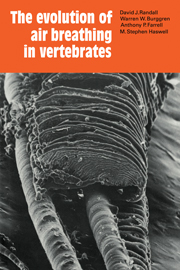Book contents
- Frontmatter
- Contents
- Preface
- 1 Introduction: air breathing in vertebrates
- 2 Gas transfer: the transition from water to air breathing
- 3 Ventilation and perfusion relationships
- 4 Mechanisms of ventilation
- 5 Regulation and control of gas transfer
- 6 The evolution of air breathing: a synthesis and summary
- References
- Index
1 - Introduction: air breathing in vertebrates
Published online by Cambridge University Press: 01 March 2011
- Frontmatter
- Contents
- Preface
- 1 Introduction: air breathing in vertebrates
- 2 Gas transfer: the transition from water to air breathing
- 3 Ventilation and perfusion relationships
- 4 Mechanisms of ventilation
- 5 Regulation and control of gas transfer
- 6 The evolution of air breathing: a synthesis and summary
- References
- Index
Summary
“Biological innovations tend to appear soon after environmental conditions become favorable to them” (Cloud 1974). Since the Paleozoic era conditions have existed favoring the evolution of air breathing in vertebrates, and many species have evolved over this span of between 500 and 600 million years.
The central theme of this book is an analysis of the changes in physiological processes that occurred as air-breathing, terrestrial vertebrates evolved from aquatic forms. Air breathing has evolved many times and was not a single event. Were the changes similar in all cases, and can we generalize, in a functional sense, about the evolution of all air-breathing vertebrates? Although there is no direct physiological evidence contained in the paleontological record, and we can only study species alive today, we believe a number of generalizations can be made. The basis for our belief is as follows. All air-breathing vertebrates have evolved from the same subclass of aquatic vertebrates, the Osteichthyes, the characteristics of which must set limits to the nature of the process. In addition, a major selective force in the evolution of air-breathing forms appears to have been aquatic hypoxia (see Packard 1974). Finally, the range of available habitats in the aquatic environment has remained the same, but with large changes in spatial distribution, over the time span of vertebrate evolution (Holland 1975; Holser 1977).
- Type
- Chapter
- Information
- The Evolution of Air Breathing in Vertebrates , pp. 1 - 10Publisher: Cambridge University PressPrint publication year: 1981
- 2
- Cited by



